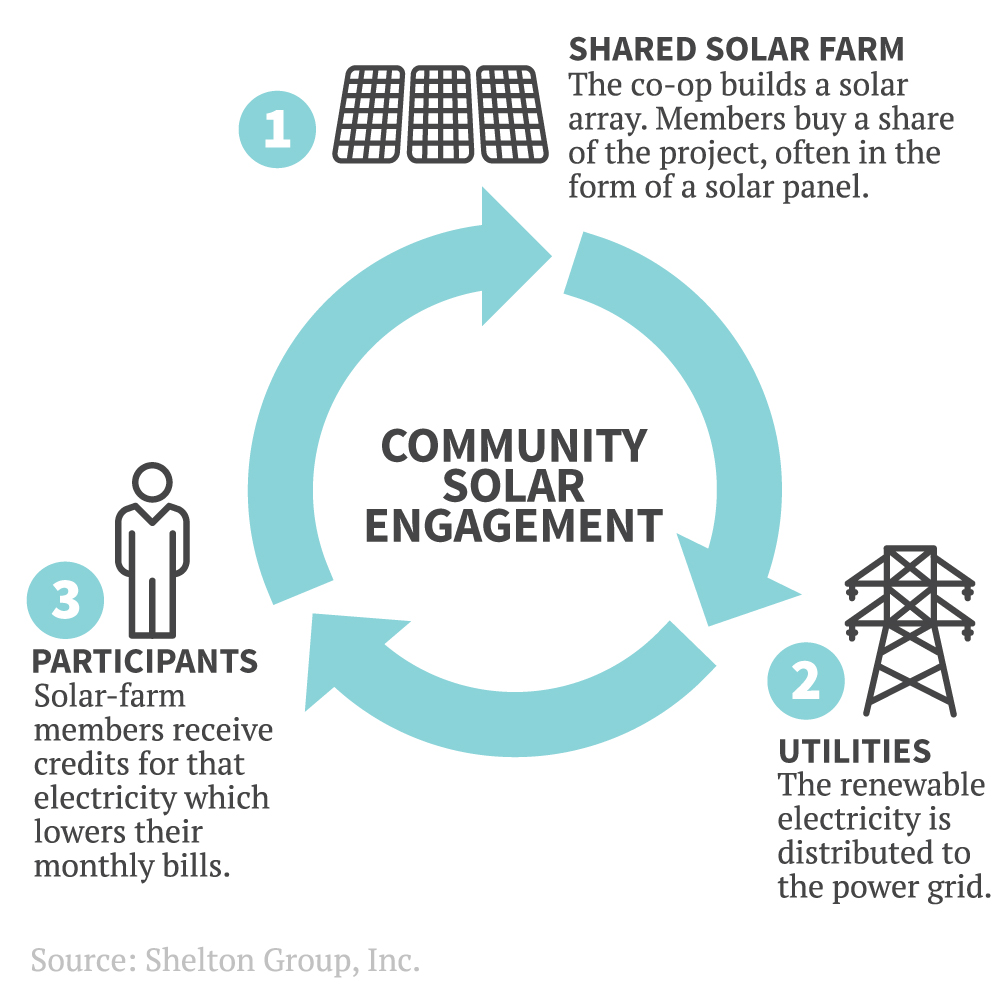Tucked away in the northern part of Michigan’s Lower Peninsula, the tiny community of Grawn gets 81 inches of snow a year, 128 days of measurable precipitation and basks in 40 fewer sunny days than the national average.
Nonetheless, Tony Anderson figured it was ripe for solar energy. And thus was born the first community solar garden of its type in Michigan, a program that enables co-op members to lease panels and enjoy solar benefits without having to accommodate rows of photovoltaic panels on their roofs.
“It’s more of a lifestyle statement,” said Anderson, NRECA Michigan Director and CEO of Grawn-based Cherryland Electric Cooperative, which operates the solar garden. “But it is a true community project and that’s the basis of what co-ops are all about.”
Cooperative community solar projects have exploded in the last seven years, since the first arrays were constructed by United Power in Brighton, Colorado, and the SunSmart solar farm operated by Dixie Power, Beryl, Utah, and the St. George, Utah, Energy Services Department. One estimate by Navigant Consulting put revenues from community solar in the United States—co-ops and others—at $175 million.
COMMUNITY SOLAR
Nearly 100 distribution co-ops in 29 states have developed or are planning community solar programs, either by themselves or in cooperation with their G&Ts. More than 70 percent of utility-sponsored community solar programs are co-op programs.
Members typically lease a panel or two for 25 years—they’re $470 each in Cherryland’s case—and receive a credit on their monthly electric bill for the solar output.
The simple scheme has drawn praise from the White House, where co-op leaders have been regulars during the last two years at renewable energy events.
But the community solar projects, which generally produce less than 1 megawatt of power, serve more practical purposes than feeling good about using clean energy.
A Matter of Trust
Third-party solar rooftop installers threaten to step between the co-op and its members. Co-ops have traditionally served as their members’ trusted energy advisors. To avoid that disruption, community solar lets members go green—or yellow, as the case might be—for a fraction of a rooftop setup.
“We need to be the ones with solutions,” Anderson said. “That builds trust and credibility with that niche of our membership. If we don’t do it, they will, and that trust will be eroded.”
No-Hassle Solar
With community solar, there are no $10,000 installations, no records to keep, no homeowner covenants to worry about, and no maintenance issues to handle. And even if you live in an apartment complex, you can say you are a solar participant.
At Greenwood Springs, Colorado-based Holy Cross Energy, 340 panels went like hotcakes at $725 each when they were first offered through the Clean Energy Collective. The collective does all the work, handling processing rebates and tax credits, tracking and applying credits to the members’ electric bill, and maintaining the panels.
“This opens up clean energy ownership to absolutely everyone who has an electricity bill,” said CEC founder Paul Spencer said.
Education
All this talk about solar energy and electric grids can be confusing to members accustomed to traditional—and limited—energy options. A community solar project lets members get a glance as to what actually is involved in distributed generation, including some of the costs, establishes co-ops as the go-to guys on solar.
“Educating cooperative members is a key driving force behind this project,” said Curtis Wynn, CEO of Roanoke Electric Cooperative in Aulander, North Carolina, and secretary-treasurer of NRECA. The project launched in 2015 at the co-op’s headquarters, with panels sufficient to generate 100 kilowatts of power.
“Our members have shown considerable interest in embracing renewable energy,” Wynn said. “This community solar farm will give them that chance, and it will also be a valuable educational tool to see the challenges and opportunities of incorporating solar energy.”
True to co-op principles: There’s no one-size-fits-all solution to building community solar; NRECA has a wealth of materials to help co-ops figure out what’s best for them. The bottom though: community solar is a true partnership, often built using local contractors or co-op employees to meet a perceived need.
Sound familiar?
“We did it the way we did 75 years ago, when we built the co-op model,” Anderson said. “I like the model of paying for it up front.”
Steven Johnson is a staff writer at NRECA.
